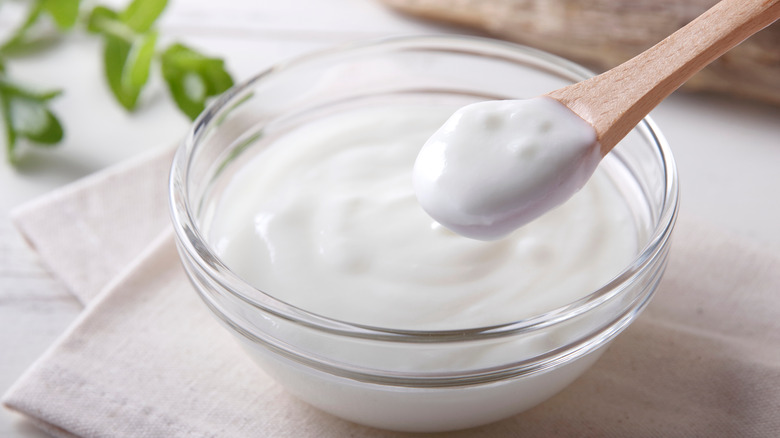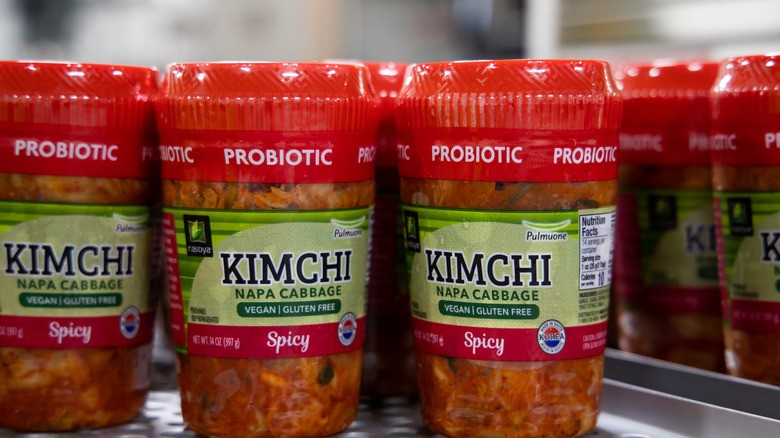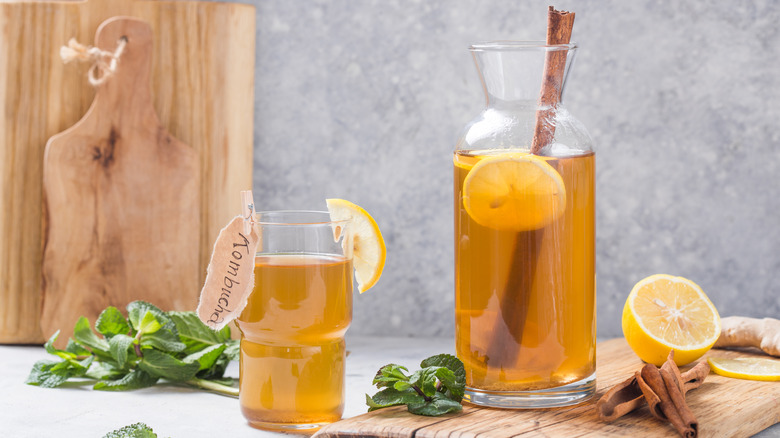What Are Probiotic Foods And Why Should You Be Eating Them?
We may receive a commission on purchases made from links.
If someone were to offer you a heaping plate of bacteria, you might blink twice before taking a forkful. Yet, there are a lot of good bacteria that are needed to keep our bodies running effectively, and those natural bacteria are generally called probiotics. According to the Cleveland Clinic, probiotics are a type of good bacteria — sometimes a yeast — that occur naturally in the human body. As the National Center for Complementary and Integrative Health notes, these good bacteria help our bodies in a lot of different functions, from fighting off bad bacteria to helping aid digestion.
But sometimes, due to diet, medications, or other factors, the balance of good bacteria in our bodies can get out of whack. One notorious culprit is antibiotics, which are intended to knock out bacteria, but often can't differentiate between the good stuff and the bad stuff. A bacterial imbalance can cause a whole host of problems, from irritable bowel syndrome and urinary tract infections to eczema, Harvard Health Publishing reports.
That's where probiotics come in. Eating foods rich in different types of probiotics can help restore the balance of good bacteria in the body, and there are a wide variety of tasty, healthy foods that can help repair and rebuild that good gut flora.
Fermented foods are a friend of good bacteria
One of the foods most commonly associated with probiotics is yogurt. Made by heating milk with added active live bacterial cultures and basically fermenting it, the milk thickens to become rich and creamy with a sour tang (via Masterclass). As WebMD notes, these live cultures provide the probiotic benefit to the gut as long as the yogurt states clearly that it still has "live and active cultures." Similarly, yogurt's drinkable cousin kefir contains a host of probiotics, as do buttermilk and cheese, as long as they have active cultures or were made from unpasteurized milk, respectively (via All Recipes).
However, there's a whole group of fermented foods that are less well known to be rich in probiotics. As All Recipes notes, fermentation is a method of preserving food where bacteria and yeast present in (or added to) the ingredients "eat" the carbohydrates — basically simple sugars. Unlike the fermentation that takes place when making wine or beer, which turns the sugars into alcohol, fermented foods convert the sugar into lactic acid, essentially curing it (via ThoughtCo). As Harvard Health Publishing clarifies, fermentation is essentially the process of transforming one food into another, like when milk becomes yogurt or cucumbers become pickles. Still, it should be noted that even if a food starts rich in probiotics, cooking or canning to at high temperature or pickling with vinegar will destroy the good bacteria.
A lot of different types of foods provide probiotics
Korean staple kimchi is gaining popularity worldwide and is a great source of probiotics. Napa cabbage is brined, then fermented, with spices added to give it a kick (via The Kitchn). But it's not necessarily limited to cabbage; other vegetables lend themselves well to fermentation. For example, Chi Kitchen produces traditional kimchi, but also sesame slaw and kimchi pickles, all of which are full of good bacteria. "Our handcrafted kimchi is loaded with 1.7 billion probiotics per serving," Chef Minnie Luong stated to Mashed. "Kimchi should be fermented and eaten raw in order to reap the benefits for your gut health, as heating it will kill the beneficial probiotics that you are looking for." But Luong points out, "Don't overlook the juice, which is also teeming with probiotics. [You can] drizzle it on rice bowls or salads."
Miso, a fermented soybean paste, is another good source used for soup but also in traditional Japanese cooking (via All Recipes). Harvard Health Publishing also notes that probiotic-infused drinks are currently very popular in Japan as well. Elsewhere, while people think of Germany's favorite dish, sauerkraut, as being high in probiotics, All Recipes notes that modern canning and pickling methods kill off the good bacteria. However, sauerkraut made in the traditional way — cabbage dry-cured with salt and left to ferment — will retain those beneficial microorganisms.
There are other ways to get your daily probiotics
Other potential sources for good bacteria include kombucha (a sweet-tart effervescent beverage made out of fermented tea), pickles made with sea salt and water (not vinegar), and tempeh, which is a soybean-based meat replacement formed into patties (via Healthline). However, because tempeh is usually cooked, some of the beneficial bacteria will be eliminated by the heat.
If none of the gut-friendly foods appeal to you, you can also get probiotic supplements. According to a National Health Interview Survey, they're the third most commonly consumed dietary supplement after vitamins and minerals. The agency notes, though, that as most are sold in the dietary supplements category rather than as a food or a drug, they are not regulated by the FDA, so consumers should look for reputable brands.
While the foods that provide probiotics vary significantly in their nutritional makeup, generally speaking, they provide a wide variety of other vitamins, minerals, and nutrients. Often, as is the case with kimchi, they can also be very low in calories. Chi Kitchen's Napa Kimchi, for example, has only 15 calories per 1-ounce serving, with no fat, 2 grams of carbs, and 1 gram of protein. Similarly, a cup of miso soup averages 40 calories, 2 grams of fat, and 3 grams each of carbs and protein (via Nourish by WebMD).



